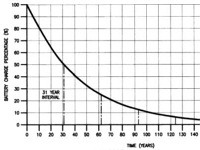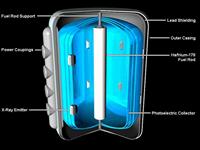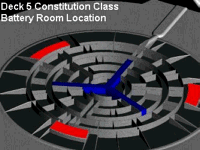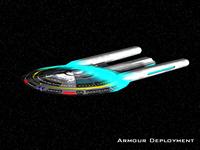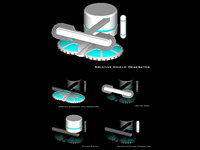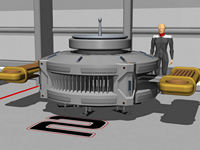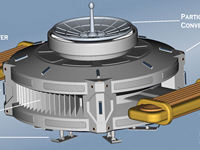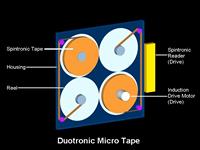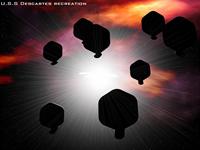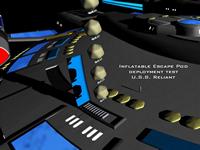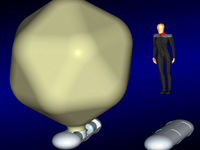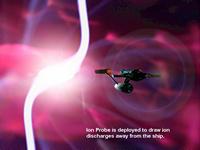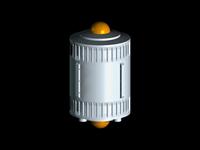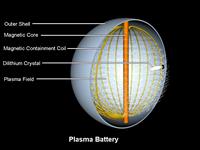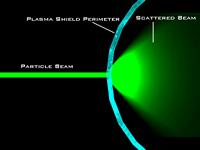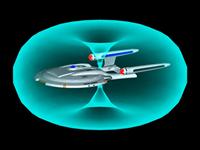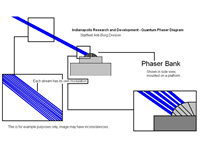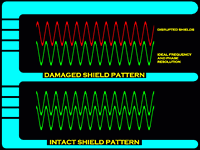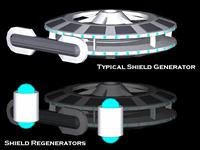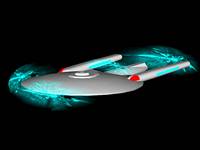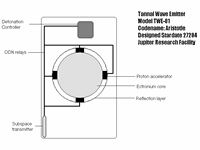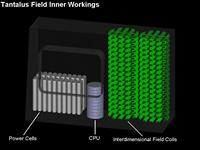Miscellaneous Technologies
Technology, Propulsion Technologies, Miscellaneous Technologies, Building a Better Brain, Faster Than Warp
23rd Century Reserve Power Cell
Devised by Robert Heckadon
There are times that both primary power and auxiliary power will fail on a starship. And so the ship then relies on its reserve power cells, or simply referred to as batteries, to keep critical systems operational on a Constitution class starship, such as life support. The reserve power cells on the ship are based upon the quantum nucleonic reactors used by the atomic planes during the Eugenics Wars.
The batteries generates power by releasing bursts of gamma rays that are collected by layers of photoelectric material to generate electric power. The gamma bursts within the battery are generated by an isotope of hafnium-178. When the isotope is bombarded with soft x-rays, it releases approximately 60 times as much gamma rays as the x-rays it was hit with. It is best compared to triggering a small avalanche by tossing a snowball onto a snow-covered roof. This reaction neither involves fusing or splitting atomic nuclei as in nuclear fusion or nuclear fission.
When the hafnium fuel releases the gamma rays, they are collected by multiple layers of photoelectric material specially designed to collect gamma rays. When a gamma ray photon hits an electron within the material, it transfers a part of its energy into the electron, releasing it from its orbit to generate electric power. The same gamma photon hits another electron and transfers its energy, and another, and another until there is virtually nothing left of the original photon.
The reaction in the battery is initiated by a series of x-ray emitters within the battery, and each emitter is powered by its own rechargeable power cell. By releasing 60 units of gamma ray energy, 1 unit of energy is used to maintain the x-ray emitters. Two units of energy to increase the reaction rate and thus increase the power cell's output. And reducing to less than one unit reduces the reaction rate. Even with most of the gamma rays released are being absorbed and utilized by the photoelectric material, there is a layer of lead lining the casing to protect the ship and crew from any stray photons of gamma radiation. The outer casing itself, measuring 1 metre high and 75 centimetres in diameter, is composed of aluminium reinforced with carbon nanotubes. In other words, low grade tritanium.
Since hafnium-178 has a half-life of 31 years, the batteries need to be inspected at every refit, which is at 5 year intervals. Which after 5 years the batteries would have approximately 90% of its original charge. 81% after 10 years, 72% after 15, and so forth. The batteries have enough power to partially recharge the phasers or to initiate a thermonuclear reaction within the impulse engines and auxiliary power generators.
These reserve power cells were replaced with the rechargeable sarium krellide power cells with the introduction of the Excelsior class starship.
References:
http://www.defensetech.org/archives/000918.html
http://www.tribuneindia.com/2004/20041008/science.htm#1
http://theory.uwinnipeg.ca/physics/quant/node3.html
http://www.walter-fendt.de/ph11e/photoeffect.htm
http://en.wikipedia.org/wiki/Photoelectric_effect
http://physicsweb.org/articles/world/11/1/9
http://www.originaltrek.com/tech/techarchive.htm
Star Trek: The Next Generation; Technical Manual
Ablative Shield Generator
Devised by Robert Heckadon
In an alternate timeline of the Earth year of 2403, two years after the Enterprise-G began her maiden voyage, Admiral Kathryn Janeway went back in time to the Earth year of 2377 in the Delta Quadrant to bring the starship Voyager back to the Alpha Quadrant. One of the unique technologies she brought back with her was the "Ablative Shield Generator." This shield generator is capable of generating a nearly indestructible metallic shell around a starship.
The Ablative Shield Generator is composed of 4 basic components:
- Subspace divergence field generators.
- Modified transporter pattern buffer.
- Molecular pattern storage unit.
- Emitter array.
The subspace divergence field has the ability to duplicate matter atom to atom of equal energy mass (E=mc^2). This field is generated in modified dual shield generators. The field is then shunt into the transporter pattern buffer where the subspace field is processed to give it an energy pattern of certain matter with the same properties such as colour, texture, and strength. The pattern is from the molecular pattern storage unit which contains the energy and molecular pattern of the metal known as adamantium. Adamantium is one of the strongest metals known to exist second only to neutronium. Why adamantium and not neutronium? Neutronium would burn out the pattern buffer instantly. Though adamantium can be replicated, the maximum possible output is only 2kg a day, so therefore, simulated adamantium is the next best solution. Also a starship does not have the energy storage to create a true shell around the ship. The newly formed adamantium pattern is sent to the emitter array where it forms a shell less than 1mm thick around the ship a few metres away, following the contours of the hull like the standard shield grid. This process differs from particle synthesis.
Since the shield generator requires a lot of power to maintain its "molecular structure," the ship has to sacrifice power from areas that also require a lot of power, such as warp drive or weapons. If for example weapons are needed, then warp engines are deactivated. If warp drive is needed, then weapons are powered down. It is a similar problem for warp capable stealth ships that uses cloaking devices such as the Klingons and the Romulans. Since the adamantium shell does not have a true molecular structure, then the shell can be opened and closed very easily in order to fire weapons for example. Opening in the shell for impulse and thrusters exhaust, warp grille and others are protected by independent force fields.
Since the shield was built in an alternate future, the temporal prime directive has halted the research and development of the ablative shield generator until the Sheliak War in the late 2380's.
References:
VOY: "Deadlock" -- (subspace divergence field)
VOY: "Hope and Fear" -- (particle synthesis)
VOY: "Endgame" -- (Ablative Shield Generator)
X-Men -- (Wolverine's Adamantium Skeleton)
Star Trek Renaissance -- (Sheliak War, Enterprise-G)
Auto-Regeneration Probe
Design by Robert Heckadon
"Okay, let's see here... Shatner, Shatner... no, doesn't look like he's in this one; we're safe." Tom Servo - Mystery Science Theatre 3000: The Movie
In the early days of the development of the Yutaka Akino class peacekeeper, it was considered giving the ship a Borg inspired self-regeneration system by linking the site-to-site transporter circuits to a replicator pattern buffer. This would then partially dematerialize the damaged portions of the hull and space frame, reprocesses them in the pattern buffer, and rematerialize in fully restored hull plating and space frame without leaving a real gap in the hull during the repair cycle. However this concept only had a maximum range of only 30 metres and required line-of-site transport resulting in the concept unusable.
But this lead the designers to develop the auto-regeneration probe.
In simplest terms, the auto-regeneration probe is a flying industrial replicator pattern buffer with site-to-site transporter circuits. One side of the probe carries the phase transition coil while the other side of the probe carries the matter stream emitter/receiver assembly both attached to fixed pylons.
The probe is driven by thrusters fueled by quaratum. Quaratum, or Hydrogen-4 fuel, is an ion fission fuel where 4 electrons from hydrogen atoms are fused together with phase-4 verteron radiation forming a synthetic strong nuclear force which stores the energy equivalent of 1/4 of a deuterium-deuterium nuclear reaction. Heavy X-ray radiation exposure from lasers releases the energy from the strong nuclear force separating the electrons from each other.
After inspecting the damage and pre-regeneration planning and programming, the damaged section is evacuated of personnel and atmosphere where force fields are used to reinforce the hull and structural integrity during the repair cycle. The probe, which is stored in a shuttlecraft hanger bay, is launched from the shuttle bay and moves within 20 meters of the damaged section. The probe then introduces new hull material at the same time as it dematerializes the damaged hull to prevent any further compromising of the hull or space frame as much as possible. Much of the raw material for the repairs comes from both storage and beaming debris that came from combat.
Due to the amount of energy required to regenerate the hull, the probe is too small to carry a strong enough power source. To combat this problem, the probe uses a particle energy converter that uses phaser beams from the ship at an energy level of 244 TeV, a frequency of 33 GHz and a power setting of 84 megawatts. To prevent the probe from being a burden on the ship's energy sources, the ship enters into a relatively close orbit around a star and uses the ramscoops to collect the high energy particles from the star and channels that energy to the phasers.
After regeneration, the colour of the repaired hull will always be off from the original hull plating because the element concentrations are never exact. As well the regenerated hull will have "bumps" on the hull, often no more than 2 millimetres, where the regeneration does not conform exactly to the ship's hull. These discrepancies are often referred to as scars or battle scars. The ship's transparent aluminum windows are often sacrificed for restoring hull integrity. The auto-regeneration probe is not capable of regenerating the integrity of the ship if the overall damage exceeds 20% and the damaged sections exceed 65%.
Critics have said that the probe would dampen the damage control team's skills in repairs. This is dismissed since not only the limitations of the probe, but the probe cannot repair more complex components including ODN lines, plasma conduit and doors.
Proponents have asked why not build the ship's space frame using a site-to-site replicator instead of traditional construction methods? In fact the space frame and hull of many shuttle crafts, workbees and other auxiliary space craft after 2377 have been replicated in whole using large scale industrial replicators, and are now looking into constructing runabout modules in a similar manner. This was credited to improvements to replicator technology and new energy sources.
Even after only 3 months after being commissioned, the designers are already working on a new regeneration probe that is simply a transporter relay unit and scanner that allows the ship to use its already existing transporter and replicator systems to reduce the overall complexity of the regeneration of the ship. Proponents are hoping within 20 years even this new probe will be rendered obsolete.
Chameleon Skin Stealth System
Devised by Chris Edmonds
The stealth system was a two-part project at Starfleet Tokyo R&D. It produced two separate components to the system. The first component, providing the majority of the stealth capability, is the chroniton field emitter device. This device is essentially a "Poor Man's Cloak", designed drastically different from a true chroniton-based cloaking device like the Romulans' and Klingons', but achieves the same, if somewhat lessened effect. The field only is capable of masking it from passing sensor scans, but not the naked eye. A starship also has to have multiple arrays placed on the outside of the hull to have an effective screen against sensors.
If someone does a more piercing scan in the direction of a ship bearing the stealth system, it may look anomalous, but would still look like normal background radiation. To further deter someone from discovering the ship, a remarkable silicon-based biological compound coats the ship's hull, laced with special electrodes. These electrodes coax the compound to change its color. The ship's computer can control the skin into matching its surrounding colors quite well. The substance has been dubbed "Photo-adaptive Hull Coverings" by the Tokyo eggheads, but the crews of ships equipped with the stealth system simply call it "Chameleon Skin". The material must completely coat the ship, so any ship with it must be specially fitted to have deployable coverings over the exposed areas on the nacelles, over the deflector, over the lifeboat pods, and over all the windows.
Several small craft designed for covert operative insertion have been developed for Starfleet Intelligence, but there's only one starship class vessel equipped with the system: the Nighthawk class.
Duotronic Microtape
Devised by Robert Heckadon
Duotronic micro tapes are the primary method of storing information onboard Constitution class starships. These tapes can vastly store more information per square centimetre than what could be stored on an X-ray based DVD-ROMs that were used on the NX and Daedalus class starships. Duotronic tapes stores their information on the basis of spintronics. Rather than using binary code, the use of 1's and 0's, spintronics uses an electron's orientation to store data, which can take on many values.
The reason that tapes are used instead of DVD's is because at the time, the material to store information using spintronics can only be a few microns thick without any real disruption in both reading and writing data, and that the material at that thickness is too fragile to withstand the centrifugal forces of a DVD player. Yet ironically, can withstand the tensile force of winding and rewinding the tape. Add to the fact that a tape's usable surface area is greater than an X-ray DVD-ROM.
The housing of the duotronic tape, which measures approximately 10cm x 10cm x .5cm, stores two rolls of tapes, each one rotating in unison with the other. A micro induction generator within the tape drive winds the tapes for reading and writing without actually coming into contact with the tape's roll itself. Duotronic read/write heads are located on either side of the disk drive scans the electron's orientation to read the information, or to alter the electron's orientation to rewrite information.
There is enough memory space on those tapes to store a complete profile of a persons DNA right down to the codon. These micro tapes were replaced with spintronic based DVDs when it became possible to read and write spintronic based information onto multiple layers of a DVD. It's like having 200 or more DVD's, that are only a few microns thick, stacked on top of one another and still be able to both read an write onto each layer.
This new storage medium was first introduced to the Enterprise class (Constitution 2 class) starships.
Source: http://science.slashdot.org/article.pl?sid=05/05/08/0041200&tid=126&tid=198&tid=14
Eagle Eye and Hawk Eye Augmented Sensor Suites
Devised by Chris Edmonds
Long range sensor arrays share the subspace accelerator coils also used by a starship's navigational deflector dish. They must often cater to the ship's navigational needs, and are taken precedence over by the navigational deflector when usage of the accelerator coils comes into question. Starfleet has long tinkered with the idea of making a long range sensor array with its own dedicated accelerator coils for a reconnaissance vessel, but lacked any viable platform for the system. When Tokyo R&D developed the stealth system, they finally had the means for a starship to take this sensor into spots where it could be utilized to its fullest.
The Eagle Eye Augmented Sensor Suite is a powerful sensor array, having a 20-minute reduction in telemetry return time over long range sensors tied in to a ship's nav deflector. There's also a much larger instrument array in the suite, allowing for much more penetrating scans. Its sole flaw is its very large size. It would be a great boon for science ships to have this sensor, but their small size is prohibitive to carrying one. To this end, a smaller variation of the Eagle Eye, dubbed the Hawk Eye, is available. The Intrepid class is currently being redesigned to accept a Hawk Eye array to increase its science capabilities.
Inflatable Escape Pod
Design by Robert Heckadon
Length inflated: 3.2m
Width inflated: 3.1m
Height: 3.8m
Length uninflated: 2.1m
Width uninflated: 0.76m
Height uninflated: 0.45m
"Love can touch us one time, and last for a live time, and never let go until we're gone." - Celine Dion; My Heart Will Go On
Sadly in situations when a starship's destruction is imminent, it will become necessary for the crew to abandon ship. To evacuate a starship, the crew uses a small sublight vessel known as an escape pod or life boat. However there have been situations where a starship's survival is measured in seconds and not minutes. Insufficient time for most of the crew to reach a life boat. These situations have increased dramatically with the Jem'Hadar kamikaze attacks against Federation and Klingon battleships during the Dominion war that began in 2373. In the Earth year of 2380, 5 years after the Dominion war's end, Starfleet commissioned its first inflatable escape pod.
The inflatable escape pod is a one person escape pod that is based upon the 21st century international space station module known as Transhab. The escape pod is stored inside a modified photon torpedo casing, which also contains the atmospheric gases need to inflate the pod, carbon dioxide scrubbers, oxygen generator, water recycler and food storage. As well as a nuclear battery for power and a veridium based emergency beacon.
When destruction or certain disaster is seconds away from occurring on a starship, the escape pods are jettisoned immediately where they then inflate in seconds while escaping the doomed ship. A site to site transporter system, independent from the ship's transporters, locks onto a crewmember's combadge and beams them into the inflated escape pod. The site-to-site transporter has a maximum range of only 50 km, and the escape pods are ejected at over 5000 km/h. This gives the transporters 36 seconds to beam crew members off of the ship and onto the escape pods.
Except for an electromagnetic sail, which doubles as radiation shields, the escape pod has no other propulsion systems. Unlike other escape pods, the inflatable escape pod cannot land on the surface of a planet safely. For maximum conservation, crew members wear a mask that delivers oxygen and removes CO2rather than collecting and venting in the escape pod environment. Depending on the species, the escape pod has only enough air, food, water and power to last 8 days. With its inflatable structure, the escape pod has more give to it an allowing it to withstand greater forces of impacts from micro meteors.
The escape pod is equipped with shields in the event of a catastrophic detonation of the ship's matter/antimatter fuel. The shields only lasts for 5 seconds and are specially aligned to ride the shockwaves away from the exploding space vessel, and a short term inertia dampening field generator to prevent the survivor from being killed by the G-forces. If the shields are not needed, this gives the escape pod another 2 days worth of power.
First tested on the Lacuna class starship, 482 inflatable escape pods are installed underneath panels on the ship's primary hull for a crew of 350. But on other starships including the Galaxy class, instead of using detachable panels, 5% of the standard escape pods were replaced with packages that contains 18 of the inflatable escape pods and the site-to-site transporter system.
Through simulation only, it has been determined that more than 90% of the crew can be rescued by the inflatable escape pods and transporter systems if a ship's disaster is within 30 seconds, in comparison to 25% in the same time frame using conventional escape pods. But sadly the escape pods were given an unexpected trial run in 2381 when the Nova class U.S.S Descartes was destroyed when a momentary deflector failure allowed a micro meteor to rupture the ship's antimatter containment field generator. Within as little as 6 seconds, the annihilation reaction consumed the starship with no chance for any of the crew to reach the standard escape pods. But allowed enough time for 12 inflatable escape pods to be deployed, and 10 crew members to beam onto the life boats safely. 8 of the pods survived the detonation of the starship's fuel, with only one survivor succumbing to asphyxiation before rescue ships arrived due to his high Andorian metabolism.
Many mourned the deaths of the 73 crew members, but were also thankful that the new escape pods were able to save the 7 crew members from the disaster. This then prompted Starfleet to increase the number of inflatable escape pod packages on starships. Increasing the number of standard escape pods to be substituted from 5% to 10%.
Ion Discharge Probe
Devised by Robert Heckadon
"You can't be afraid of the wind" - Dr. Henry Archer
Ion storms. Magnificent and deadly. They have claimed more lives than any other natural phenomena in space. When one encounters these storms and cannot be avoided, a ship activates a magnetic shield that bends the ionic discharges away from the ship. The magnetic shield is often generated by realigning and re-polarizing the ships hydrogen collectors. But often, these storms become so violent and so powerful, the ship either becomes severely damaged or destroyed. To help protect the ship from the ionic discharges, it launches an ion discharge probe.
First issued in 2267, the ion discharge probe, or simply referred to as an ion probe, is essentially a "lightning rod" for ion storms. When the probe is launched from the ships torpedo bay or dedicated hatch, it generates a powerful magnetic field that draws in the ion discharges away from the ship, creating an "eye" in the storm. The ion discharges flows towards the probe through the magnetic field until it reaches a "hump" in the magnetic field. This "hump" surrounds the probe itself so that it can survive long enough to maintain the magnetic field.
The probe was originally built by ion storm chasers which later went into full scale production by the Federation Corp of Engineers. The probe itself measures 80 centimetres in diameter and 1.35 metres in height when the globes, as they are commonly called, are not deployed. The probe is chemically fuelled with 4 high output thrusters to provide the thrust to get a safe distance away from the ship before activating. It then manoeuvres itself into the correct position so that it can draw the ion discharges towards itself while putting the least possible risk to the ship.
The centre of the probe contains a series of magnetic field coils to generate the field. The top and bottom of the probe has 2 globes that when deployed, via a 100 metre tritanium tether, collects a small percentage of energy from the ion discharges to power the magnetic field. This then saves on room, space, and cost for a power source for the probe. These globes are propelled by chemical rockets.
An early attempt at ion "lightning rods" involved a 1 kilometre long tritanium cable. However, the tritanium cable concept can only survive one discharge and is often not fully deployed, usually less then 30%, when the ion discharge strikes it. Whereas the ion probe can survive several discharges and not have to worry about being fully deployed.
Starfleet versions contains complex sensor arrays that can study the ion storm and transmit as much of information as possible back to the ship. Thereby construction better ion probes or reconfiguring the ship's magnetic shields to withstand heavier bursts of energy.
After the ion storm, almost all that is left of the probe are a few strands of disintegrated carbon nanotubes from the tritanium shell of the probe. Which would be all that was left of the ship if it wasn't for the sacrifice of the probe.
Plasma Battery
Design by Robert Heckadon
April 5, 2063. Earth's first warp capable ship was launched. The Phoenix's ability to travel beyond the speed of light with spare parts is an achievement onto itself. But it took 6 months to salvage enough titanium to build a 4 metre cockpit. So what of an energy source? The O'Neil space colonies had vanished 5 years earlier from a failed warp experiment. Earth hadn't discovered Dilithium yet. Though having sufficient antimatter, the Phoenix couldn't be used safely in a vessel that small. But Zephram Cochrane used an alternative power source called a plasma kinetic energy storage vessel, commonly referred to as a plasma battery.
Plasma batteries store energy as high velocity plasma that orbits a dense magnetic core at the heart of the battery. When energy is loaded into the battery, it accelerates the plasma to high speeds, resulting in the increase of its kinetic energy level without adding fuel or reactants. Essentially storing the energy in a plasma "flywheel." A device from the 20th and 21st century. The speed of the plasma can range from a few thousand kilometres per second all the way up to half the speed of light, depending on its purpose. To make use of the energy stored in the battery, the plasma is channelled out of the battery, fine tuned, and distributed within an EPS power grid. Typically channelling the plasma out of the battery makes use of a power transfer crystal. For plasma batteries that are used for storing a ships excess EPS energy, impulse power, or other fusion/nuclear level power systems, a boride crystal, which are typically found in EPS transfer nodes, is used. The speed of the plasma ranges from 10000 km/s to 100,000 km/s.
Plasma batteries that are rated for warp power, planetary power, or other antimatter level power systems, are using a dilithium crystal. The speed of the plasma ranges from 100000 km/s to half the speed of light. Though some custom made batteries are designed to handle 3/4 the speed of light. The batteries can also be directly used as a source of sublight propulsion. Indirectly, the batteries can power an ion drive. But directly requires opening a hole in the magnetic containment field and venting the high velocity plasma out an impulse engine. By coining Sir Isaac Newton's third law of motion, the action of venting the plasma out of the engine causes an equal and opposite reaction of forward thrust.
The magnetic core is a long hollow superconducting rod at the centre of the battery. It generates a very high voltage, very low amperage magnetic field to allow the plasma to orbit it. One end of the rod branches off at several dozen points and meets at the other end of the rod. This both provides a secondary containment field for the plasma as well as completing the circuit with an anodyne transformer to provide the mega voltage required. The magnetic field is shaped to concentrate the field inside the battery, while the external magnetic forces from the battery are no greater than a decorative replicator magnet. Cryogenic refrigerants fill the hollow rod to significantly reduce its electrical resistance, and thereby reducing the power consumption to maintain the field. The power for the magnetic core comes from the kinetic energy of the plasma.
In simplest terms, plasma consists of atoms stripped of their electrons. Typically plasma batteries uses hydrogen plasma, also known as protons, with a few batteries using helium plasma, also known as alpha particles. The electrons from the plasma flow within the magnetic core itself, providing the core with an additional charge to reduce power consumption on the containment field.
Since plasma batteries are non-perpetual energy sources, they always require an external energy source to recharge. If the batteries are used as a tertiary power source, or to store excess EPS energy from the main generators, then they are recharged by the ships nuclear and antimatter power sources. If the plasma batteries are used for warp power or as a primary power source, then the batteries are recharged by using solar energy, often using a solar power plant that harnesses the energy of a solar flare.
With their non-nuclear and non-annihilation nature, plasma batteries are very appealing to commercial and civilian ships because then they don't have to worry about licensing, permits and so forth regarding antimatter. Although they still need permits related to nuclear energy because one kilogram of plasma travelling at a mere 10000 km/s has the kinetic energy equivalent to an 11 kilotonne atomic bomb. While 25000 km/s with 1 kilogram of plasma is equivalent to a 68 kilotonne bomb. Often the speeds for impulse rated batteries are in the 50000+ km/s range.
Warp-rated plasma batteries can be stored onto a starship so that they can be used as a replacement power generator for an alien ships faster than light propulsion system, provided that the alien ship is not too big for the rescue ship to handle the power transfer. And doing so without betraying any Federation secrets to a hostile or potentially hostile species. This includes the Galaxy-class Enterprise-D on stardate 45892.4 rendering aid to a disabled Romulan science ship that unknown to the Enterprise was testing a new phase cloaking device.
Starfleet and many other species within the Federation still prefer to use antimatter because of range, power output, and that antimatter requires significantly less energy to restore than plasma batteries. With the introduction of the Sovereign class starships, plasma batteries that were normally used to store excess solar, nuclear and antimatter energy have been slowly replaced on Star Fleet vessels with trisolaric crystals, that can store the energy within their crystalline structure. But plasma batteries still remains with species who are entering their warp era, as well as taking civilizations to the stars and within the Federation.
Plasma Shield
Devised by Robert Heckadon
From the time that humans finally began to travel to the stars, they knew that they would encounter alien beings that do not wish to have peaceful relations with those explorers. Originally they used polarizing the outer hull plates, a method of increasing the tensile strength of the hull, to protect them. But this means that the hull still sustains a considerable impact from particle beam weapons. After the mission to stop the Xindi planet killing weapon, a new form of defence was developed. A new type of force field, based on old technology, that helps protect the ship from enemy weapons, the Plasma Shield.
The plasma shield is a concentrated magnetic field 300 metres in diameter that contains 500kg of hydrogen plasma. The hydrogen plasma is used to help scatter particle beams and plasma bolts before they hit the ship. The scattered particle beam is distributed over a much greater area of the ship's hull reducing the force of impact on the hull by as much as 85%, depending on the momentum of the particles and the type of weapon used. The other 15% is compensated by the polarized hull plates. The shield can also help protect the crew from interstellar radiation and ion storms.
The plasma shield is not really based on latest technology, but on relatively old technology. It is based on a drive system used by the old DY-100 starships to travel from Earth to Mars. The M2P2, or mini-magnetospheric plasma propulsion drive. Its basic principles are the same as the plasma shield generator. The shield is a high power magnetic solenoid that generates a natural forming magnetosphere that has plasma injected into the magnetic field. Whereas the M2P2's plasma field can range in the distance from 50km to 100 km, the plasma shield is designed to restrict the diameter of the plasma field to no greater than 300 metres, concentrating the plasma to a point where it is virtually solid.
If a particle beam's momentum is sufficient, it can disperse some of the shield particles reducing its optimum concentration. The primary reason hydrogen plasma is used for the shield is because hydrogen is the most abundant controllable matter to exist (dark matter is not controllable by 22nd century technology). Therefore the shield can be brought back up to full strength by introducing more hydrogen plasma into the shield until its hydrogen supply runs out.
The plasma shield does have several restrictions. Though starships can carry large quantities of hydrogen, increasing the hydrogen plasma concentration well beyond the 500kg limit will also increase the ambient magnetic field strength. This could result in many of the ships systems to lock up. A section in the shield needs to be opened in order to fire a particle beam or projectile, such as a phase cannon and photonic torpedo, through the shield. The shield can also interfere with the formation of a warp field.
Even though the plasma shield is to be used in conjunction with polarized hull plating, many commercial and civilian ships have opted to use the shield generator alone due to lower costs of the generator and material, and simplified maintenance and construction of the shield generator. In the beginning of the 23rd century, the plasma shields were replaced by graviton polarity source generators and subspace field distortion amplifiers, which are still used by 24th century starships.
References:
Star Trek: The Next Generation Technical Manual
http://www.geophys.washington.edu/Space/SpaceModel/M2P2/
The Pulse Plasma Cannon and the Trick with the Phased Plasma
Devised by [email protected], translation by Bernd, ASDB Member
Abstract
The PPK (Pulse Plasma Cannon) is a highlight aboard U.S.S. Taranis. The device is based essentially on the pulse cannon as it was first used on the U.S.S. Defiant. The pulse cannon belongs into the category of phaser weapons. But instead of firing continuously, the beam is compressed to a multilayered pulse in an extremely purified crystal. The pulse itself is composed like an onion, with its many layers.
Description
What is this useful for? The pulse consisting of multiple layers, it is harder to disperse b the shields of an enemy ship and therefore capable of doing more damage. The new PPK technology takes up this principle. The emitter for generating the pulse remains the same. However, instead of just releasing the beam on its journey to the enemy, it runs through a tube with eight plasma fields. What is the role of the plasma? Wouldn't a strong plasma field disperse the beam? About the first question: The plasma is being integrated into the pulse. Second question: Yes and no. Yes, the plasma would dissolve the beam under usual circumstances (and the enemy ship would not encounter more than a slight breeze). The plasma, however, is being put into phase, in a way that only 25% of it is still in normal space. How is this going to help integrate the plasma, now that the pulse can virtually run through the plasma field without damage? Isn't this all useless after all? Well, now the remaining 25% come into the game. We will discuss this one by one.
Let us look at the pulse first. As the pulse begins its compression, a core forms. This is nothing but a "fat bubble of plasma energy". For the PPK, in addition, this bubble is being put into a phased state. The ratio is exactly the complement of that of the plasma, meaning that 75% of the pulse is in normal space (it can't be phased any further, otherwise the pulse would collapse; it would be missing its foundation). Now we are sending this modified pulse through the plasma phase tube. There, it is moving through the plasma wall. And nothing happens. There is still something to be done. Before our pulse engages into a divine connection with the plasma, the part of the plasma core that is in phase must be more or less erased. Suddenly the energy level of the core has dropped by a quarter. What has happened? An "energetic vacuum" has formed. And what do we all know about vacuums? Exactly! The pulse would inevitably collapse (through the energy vacuum). Yes, I know. We should stop always to destroy the poor pulse, but we are almost through with it. Now it is getting really interesting: The 25% that are missing in the pulse, the pulse will take back from the 25% of the plasma stream. This is done four times, in eight steps (each time an exchange of 12.5%), in order to replace the complete core bubble. This is how the plasma gets into the pulse.
The attentive reader will wonder if an "energy vacuum" would not form in the plasma beam itself. Yes, but this is the same as if a glass of water is drawn from a waterfall. The remaining "hole" is being closed by the following water or plasma, respectively. A further question may be if the plasma inside would not begin to burn the whole from inside. It would. But every new core possesses a slightly opposite charge to the rest of the projectile. Thereby a tiny isolation layer will form.
Now we know how the plasma is introduced into the pulse. The most important question, however, is what the whole effort is useful for. As I already explained in the beginning, the pulse as such is harder to disperse by shields than a normal phaser. Let us start with two cases: "the plasma pulse only interacts with the shields" and "the plasma pulse (or a part of it) hits the hull". In the first case, while the single pulse layers damage the shields the plasma destabilizes them. This effect may last for several seconds, depending on the type of shields. Case two: Plasma on the hull. This works similarly: The standard pulse yields damage, while the plasma acts like an acid that dissolves the outer hull. There is, however, not a superweapon without a little catch to it. It is the size in this case. The introduction of plasma only works in steps of 12.5% without the danger of a collapse. In order to replace 100% of the core, eight plasma injectors are required that have to be placed in a certain distance, o give the pulse enough time to recover its single phase states (it is only a question of time). This will unfortunately result in length three times that of the original. The projectile itself is handicapped as well: the isolation layer will degrade over time. And if this should fail...
Conclusion
Summarizing, the disadvantages are not a big deal. Only the range is a little bit shorter than of the normal pulse. If we were to categorize the PPK, we would describe it like this: "The pulse plasma cannon. A short-distance combat weapon with a certain surprise factor."
Quantum Phasers
Devised by Indianapolis R&D
Indianapolis R&D Quantum Phasers Intro
This technology was theoretical as of 2375 and in testing as of 2379.
Motivation
Anti-Borg technologies almost have to be researched, a line must be drawn and formidable defenses must be designed if the Federation wants to survive another attack, and the possibility of a multiple ship attack. Primary weapons such as phasers are effective until a point is reached that all modulations are ineffective against Borg shields. That is the problem we are addressing. It is our goal to create a phaser weapon capable of multiple modulations and also powered by harnessing zero-point energy as quantum torpedoes do to make them more powerful as well as more effective against the Borg. The technology constructing a phaser array made up of individual emitters that fire the same way conventional phasers do, with a twist. The discharge is made up of several beams with their own modulation, thereby hitting the opponent's shields with multiple modulations. Before reading the example remember that a typical quantum phaser bank would be made up of thousands of emitters, therefore hitting Borg shields with a phaser beam made up of at least 500 streams from the emitters. The individual emitter would share the circumference of a basketball.
Example
Let's take a simple phaser beam that is discharged from 5 streams from 5 emitters with random modulations of 96.212, 58.313, 26.990, 98.012, and 73.0112. Adaptation is highly unlikely with so many modulations. To further complement the design, those 5 emitters would continue to modulate after firing.
Problems
The quantum phaser array is expected to consume three times the power conventional phasers do. The solution may prevent implementation on current ship designs. The solution is to install a power core to independently power weapons and shields. This also relates to our other technology (Multi-Grid Shielding). As we said the installation of a power core may prevent existing ships to converting to the new weapon. It may be possible to install this core in a cargo bay.
Implementation
Fleetwide conversions should be made with ease, granted that a power core can be successfully installed into the existing ship. The new bank will take no more space than the previous one did. Newly designed ships will almost certainly be equipped with the new weapon.
Conclusion
The Quantum Phaser Array should prove to become a valuable asset to Starfleet. The ability to effectively oppose the Borg and win, without losing dozens of ships is priceless in the eyes of Indianapolis R&D.
Thanks to Lt.Gardnier, whose good point gave me the idea for this technology.
QFF - A Look into the Darkness
Devised by [email protected], translation by Bernd, ASDB Member
Introduction
The QFF may look insignificant. But it is one of the most indispensable technologies aboard the Taranis. QFF is an abbreviation that stands for Quarks Fluid Filter.
Theory
The name may seem strange at first glance, but this will become clearer in the course of this text. Our fluid is meant to operate at warp flight in the first place. More to the point, the fast warp flight. At high warp factors the ship is deeply immersed into subspace. This corresponds to a high speed. But it also means a strong reduction of sensor signals, as penetrating the subspace layers is always becoming harder. In other words: the faster, the blinder. This is only seldom a problem, even on newer ships. They either don't achieve very high warp speeds (Warp 9 or more), or they are not able to maintain them for a longer time. If you are familiar with the Taranis, you know that this ship achieves Warp 9.9999637. Using sensors would not only mean that their performance would be reduced, but rather that the ship would be blind. Something needs to be done about that. The QFF is the solution. Explaining the name, "quarks" refers to the subatomic particles inside atoms, of which the protons and neutrons consist. Imagine a large tank full of these tiny particles. No molecules, no atoms, only quarks. There are so many of the in the tank that they would form a kind of fluid. Now we have a tank of quarks. What else? How can we see through the subspace layers, to hold the course and maybe to make some scans? Can we increase sensor power? Can we envelop them into a subspace field to actually get them out of subspace?
To increase sensor power is a good idea, but not sufficient. The subspace field around the sensors is a good idea in theory, but not more than that. To elucidate this, we need a small though experiment: The sensor array is taken out of the warp field using an additional subspace field. The sensors are now in normal space. We could perform our measurements with ease, but the speed would drop to zero, while the ship would still be moving at warp.
Implementation
What have the Taranis designers done? We have done almost the same as described above. Only a little bit differently. Instead of creating one large subspace field around the whole sensor array, we are satisfied with a field that encloses a sphere of 10^-12cm of vacuum. This vacuum is put into the center of our tank full of quarks. The sphere later serves as a window to the outside. Right, a very small window. But for our purposes this proves sufficient. Before we go one, some further considerations: We all know what a sphere looks like. Let us imagine we could walk on the surface of a sphere around a vacuum. We frequently look up and we will notice that we will be able too see everything around the sphere, provided that we stand at a suited point. This thought will be relevant later.
Let us go on with the "vacuum sphere" in the "quarks tank". Normally, this sphere would be surrounded by our fluid quarks. But we are forcing them to form a shell around this sphere. The interior of the shell is incredibly "tight" and also very "smooth", to take macroscopic equivalents of the sub-atomic properties. Repeating what we have so far, we have flooded a tank with quarks. Amidst them , there is a small sphere that encloses "nothing". The quarks form a shell around the sphere. There is nothing between them (maybe except for a small rogue quarks). The wall of the quarks sphere is extremely smooth and tight. Now we are generating a small subspace field in the vacuum sphere, strong enough to neutralize the warp field for the most part. The vacuum sphere being very small, a tiny amount of power is required for that. Now we have a our window to the outside world. But what are the quarks useful for? We claim that we are able to scan anything within a range of 12 light years around the Taranis, with weak or medium resolution. And this even at the highest warp factor that the Taranis is supposed to achieve. How is this possible? With the help of the little quarks. As the tight and smooth surface is very reflective, we may exploit this property for our sensors. The sensor rays are directed towards the interior of the quarks sphere, they are reflected and penetrate the forcefield of the vacuum sphere, and they go straight through the core of the sphere. There the warp field is nearly neutralized. Now our sensor rays are in normal space. Considering the above mentioned properties of the sphere surface, the rays may egress from every point of the surface and may scan every point in its surrounding.
Summarizing the scan procedure, the sensors are programmed in a way that arbitrary points of the quarks sphere's inner surface are scanned. The beams are reflected and take their way to normal space. What do we need the quarks for? Couldn't we as well take the vacuum sphere? This would suffice in principle. It would work at least partially without the quarks. For once, we take profit of the magnification effect: The quark sphere's inner surface is exactly 5.5 times as large as the area in which the warp field has been neutralized. If we scan a point on the inner surface and then move 5.5cm to a lower point, the corresponding distance on the vacuum sphere is only 1cm. This way, we can enhance our resolution compared to the direct way. In addition, the more we enlarge the image, the smaller may the subspace neutralization field. And this will save energy! A further reason for the quarks is that otherwise the sensor array would have to be moved around the vacuum sphere. But with the quarks we only need to point at a certain coordinate of the interior.
But we could also ask why the rays are reflected only from the inner, but not already from the outer surface. This is what we needed to ponder about for quite a time. Our solution: We form some sort of hose in the quarks fluid which begins at the outer hull of the tank and ends as late as inside the quarks sphere. This hose always follows the movement of the point to be scanned. This way, we always have a corridor for the sensor rays to get straight through the quarks.
Conclusion
Now let us mention the disadvantages of this technology: We need more than only one computer core to make all the necessary calculations. The corridor through the quarks and the target point for the inner surface of the quarks need to be taken into account. The calculation of the lead point, however, is much more extensive. We are moving at superluminal speed after all. We need to calculate where to target our rays, to hit the desired object and retrieve the reflected information at the right instant. In spite of some savings, the energy consumption is enormous. To make things worse, the measurement results are rather scarce, compared to all the efforts taken. But we shouldn't make the technology worse as it is. After all, we have enough sight at warp speed, albeit not quite as much as at impulse.
Regenerative Shield Generator
Devised by Robert Heckadon
During combat situations and other hazards, starships protect themselves with the use of deflector shields. Unfortunately deflector shields cannot last forever and can be damaged themselves. Deflector shields utilizes one or more graviton polarity source generators whose output is phase-synchronizes through a series of subspace field distortion amplifiers. When the shields sustains some form of critical impact, whether it is energy or matter based, the synchronization of the polarized phased gravitons are disrupted which affects the properties and effectiveness of the shields. Shield percentage is based upon the "structural" integrity of the shields. These disruptions cannot be repaired while the shields are online, not even by retuning and alternating the shield frequencies. Until now.
Traditional shield restoration
One traditional method of restoring shields to full strength is to reformat the shield matrix. The resynchronization and phase correction of the shield matrix. This process requires deactivating the shields and recharging the shield emitters. This process can take 30 seconds to several hours to complete, depending on the damage and disruption to the shields and their generators. This time frame can leave a ship vulnerable to an enemy attack.
Another method is to reroute power from other sources to "thicken" the shields, increasing the spatial distortion fields by which the shields operate. Varying power to the shields unfortunately does not discriminate between disrupted shields and usable shields. When shields are at 75% integrity, they need to increase power by 33% to bring shields to 100% optimal strength. However the disrupted shields will increase by 33% as well. This process also increases risk of overload of the power systems and networks throughout the ship.
Shield regenerators
Shield regenerators are units that restores the shield matrix while the shields are still operable. Deflector shields rotates and retunes frequencies at certain intervals, every 500 million cycles, or operating at a frequency of 250 megahertz (MHz) every two seconds. By using these frequency "windows", which are also used by the ships active sensors, the shield regenerators filters out about 5% the out-of-sync shield frequencies and are de-compiled. Therefore the energy that sustains the disrupted shields is no longer required and is reused into generating new shields. With 5% filtration, it would take about a minute to restore 80% of the damaged shields while operating at 250 megahertz.
The regenerators requires considerable amounts of power themselves. Power can either be fed through the auxiliary power networks, or by temporarily diverting some shield power to the regenerators. Near instantaneous regeneration would be too energy expensive for the ship and would burn out the filters immediately. Ironically, if the shields have degraded to below 40% integrity, then the filters requires far less power to restore the shields than if they were at 70% because the disrupted shields are "easier to find." Yet below 25%, the shield damage is irreversible without deactivating and reformatting them.
A few weeks before the end of the Dominion War in the Terran year of 2375 A.D., only 2 ships were equipped with regenerative shields. The U.S.S. Prometheus, which was the prototype of the new class of battle ships of the same name, and the U.S.S Sao Paulo, later known as Defiant-2. Later these shields were introduced into the Phoenix class starship, such as the Enterprise-G.
References:
Star Trek: The Next Generation Technical Manual
VOY: "Message in a Bottle"
Star Trek Renaissance
Soil Cultivator or Cultivator
Devised by Infosaur
Tool used for farming on colonies, predating the replicator
A farming/colony tool for injecting nutrients into inert soil at the molecular level. More advanced than an electron microscope but far more primitive than a replicator. These primitive terraforming tools began to be used in the mid-21st century when the first extra-terrestrial colonies began on the Moon and Mars. By the mid 22nd century they were so prevalent that any descriptor of size and/or weight would be futile. They can be as small as a cubic meter or as big as a large shuttle. Some were self propelled but usually on tracks or wheels. A small or personal cultivator could process an acre of soil per day, larger ones could process metric tons per hour. Most Sol-System colonies had at least two cultivators on site. Once extra-solar colonization missions began a two units per ship minimum was usually expected. A standard cultivator usually has some sort of port or maw into which inert soil (i.e. asteroid rock) is fed. Smaller units can be hand or belt fed, larger units can dig directly into a surface. Two materials tanks or hard point connections for them are connected to the premix chamber. The injector chamber is a sealed unit with a high pressure injector mounted perpendicularly. The output is often just a hole at the back of the unit, although sometimes a 'blower' unit is attached. Older units are particularly robust and often prized by collectors of the esoteric. Earlier units are often crude but easy to repair, later cultivators are more efficient but often used more delicate parts making repairs difficult. There have even been sightings of units still in operation in the 24th Century. And a working '2062 Kansas Tornado' is at the Federation Hydroponics Institute museum.
Tannal Wave Emitter
Devised by Dave JB
Motivation
In the late 2340's, a group of Starfleet Engineers became interested in the concept of remotely disabling a ship without harming the crew. They discovered that in World War III, some nations had deployed electromagnetic pulses to disable enemy electronics. This would not work on a starship though, as the systems were not susceptible to EM pulses. However, in 2348, a group of scientists studying Ectronium, a (then) recently discovered element noticed that their instruments were experiencing intermittent failures. An analysis showed that every half life the atom of Ectronium emitted some sort of wave which caused damage to the instruments. These waves were named Tannal Waves, after the head scientist of the team, Dr. Tannal. The team cooperated with Starfleet engineers and came to the conclusion that Tannal Waves could be used to create a disabling weapon.
Weapon
The initial design involved generating a large amount of Tannal waves and emitting them via a pulse cannon-like design. This was abandoned when it was realized that the waves were very difficult to contain due to their extremely high frequency. The next method involved firing a slug of Ectronium in a torpedo, and exploding a normal warhead, which would scatter fragments of the Ectronium around the target, acting like a chaff. This design it was theorized would only disable about 6% of the systems on an Ambassador Class equivalent, so it was equally unsuitable. The third design involved another old concept - that of nuclear fission. Since Ectronium atoms split very easily, it was reckoned that a sphere of Ectronium 18cm in diameter would emit a colossal blast of Tannal waves, enough to completely disable any design at the time.
The prototype weapon involved the aforementioned sphere of Ectronium surrounded by a layer of material which would deflect all protons (which split the atoms) back at the Ectronium. At various locations between the reflection layer and the Ectronium were 4 proton accelerators which would initiate the reaction. It was estimated that the full mass of Ectronium could be consumed in 0.7 seconds, emitting Tannal waves up to a radius of 360KM, and generating a small thermal pulse. This design could be employed in a modified torpedo casing.
Testing
The first reaction unit that was made (TWE-01, "Aristotle") was detonated on Stardate 27534. The only thing in the vicinity was an observation unit which would transmit telemetry before being disabled by the heavy emission of Tannal waves. In the 1.2 seconds it transmitted, it reported that the reaction had been clean, with minimal secondary effects, other than a brief thermal pulse around 700 degrees Celsius at the center. The actual reaction had been slightly faster than theorized at 0.62 seconds. On later inspection, it was discovered that only 72% of the Ectronium had been consumed in the reaction. Most of the material at the core of the Ectronium sphere had not been consumed due to the reaction dying out.
For the next test, the test unit (TWE-02, "Plato") had a small conventional explosive placed at the center of the mass. When tested, the results were exactly the same as the previous test. It was discovered that the Tannal waves had disabled the control circuit for the conventional explosive's detonator.
A modified explosive was made for the third test unit (TWE-03, "Copernicus") which would not be affected by the Tannal waves. This time the explosion compressed the mass of Ectronium just as the reaction started. This increased the speed at which the reaction took place (0.45 seconds), and the entire mass was consumed, with the Tannal wave emissions increased by around 29%. This design was concluded to be satisfactory.
The fourth test it was decided would be conducted with a starship in the vicinity. The USS Huddersfield (Oberth class, NCC-21834), which had been retired after suffering structural damage while studying a black hole 3 years beforehand, was used as the test subject. The device used was of the same design used in the third test. The test itself went to plan; the Tannal waves passed straight through the shields of the Huddersfield, and disabled all systems on board. However, upon inspection by an engineering team it was discovered that every system on board was irreparably damaged. Moreover, had the Huddersfield been carrying any antimatter, it would almost certainly have caused a catastrophic failure of the antimatter containment.
The emitter's design was changed somewhat for the fifth unit. Instead of the 4 large proton emitters, 20 smaller emitters were used. Instead of the conventional explosive (which was believed to have caused the reaction to become too intense) at the middle, a second reflection layer was added. The testing went well, the test subject was disabled but not severely damaged.
The sixth test was a sham battle between the USS Ranier (Constellation class, NCC-4346) and the USS Hancock (Ambassador class, NCC-19832). The Hancock was armed with a torpedo containing the components of the Tannal wave emitter. The torpedo was fired at the Ranier, which was disabled completely, and tractored by the Hancock.
The weapon was considered a success, and Starfleet considered arming the fleet with this new technology, when a devastating blow struck; the 6 people on the USS Ranier had all fallen ill, suffering problems with the immune system, digestive tract and muscle control. Tests revealed that in large quantities, Tannal waves were extremely hazardous to biological life. The maximum safe exposure level for humans was far below the level needed to disable a starship.
After much deliberation it was decided to halt the development of the weapon, and in 2351, Tannal wave based devices were banned in the Federation, with the Klingons doing the same in 2353. During the Dominion Wars, Starfleet toyed with the idea of using Tannal wave devices against Dominion ships, but the idea was never really accepted.
Conclusion
While Tannal wave based weapons would have allowed Starfleet to capture and study enemy ships, the effects on biological life were considered too great a cost to use the weapon. It did not help that the design had been rushed (there was only 5 months between the discovery of the waves and the first test) and the effects of Tannal waves not properly studied. This led to new guidelines which required new weapons to be adequately researched and simulated.
Tantalus Field Generator
Devised by Robert Heckadon
"The perfect assassin must be in total balance, possessing skills of creation as well as destruction, in accordance with the teachings of the Ninjitsu." - The Way of the Haiku
In an alternate universe, where good is evil. Rather than to seek out new live and new civilizations, Starfleet conquers and dominates. Under the impression of developing a new method of nuclear waste disposal for Commander James T. Kirk, first officer of the Imperial Star Ship Enterprise, a mysterious alien unwillingly develops the perfect, and considered most frightening weapon of assassination. The Tantalus Field.
The Tantalus device is a machine based upon the Elway theorem. Rather than matter/energy transportation, the Elway theorem transports through an interdimensional fold in space. In the case of the Tantalus field, the subject is transported from their present location into the heart of a star, where all matter is broken down in the star's nuclear furnace leaving no traces of the victim. Transporting though a space fold is not normally detected by routing sensor scans, whereas standard transporters usually leaves behind a residual ionization signature. Therefore no body to do an autopsy on. No obvious weapon to examine. No transporter signature left behind. No piece of evidence will ever be found. No way to link the killer to the victim. The perfect assassination.
The Tantalus field generator itself is approximately the size of a brief case, making it easy to transport and conceal. The device is equipped with duotronic interface ports, equivalent to USB ports, to tie directly into the ship's internal and external sensors, using the internal or external sensor to lock onto the victim, and either the internal or external sensors to lock on to the nearest star. All from the safety of his own quarters. The range of the Tantalus field has not been determined, but theoretically has a maximum range of over a billion kilometres. The Tantalus field generator requires significant amounts of energy, and is therefore powered by a series of sarium power cells, similar to hand phaser power packs. Thus having enough energy to make 3 people "disappear" in one time frame. The power cells require 24 hours to fully recharge, and the recharge rate needs to be low so that the power usage will not trip any of the ships security sensors.
Though a formidable starship captain, James T. Kirk has been held back from having a command of his own due to a charge of a sexual assault he committed against Dr. Carol Marcus, resulting in the birth of David Marcus. And Kirk is being constantly left in the shadow of his commanding officer, Christopher Pike. However, in this universe, if a captain were to die suddenly, regardless of any criminal charges, including rape, then the first officer will be given a field promotion to Captain if evidence shows beyond a reasonable doubt that the first officer had nothing to do with his Captain's death. The first victim of the Tantalus field, Christopher Pike.
Sources: http://www.ussfreedom.net/Encyclopedia.htm, http://server2.powernet.net/~jcrafton/tech-e.html, http://calgacus-wasabi.typepad.com/ninjapanda/, Star Trek: The Original Series: "Mirror, Mirror", Star Trek: The Next Generation: "The High Ground"

